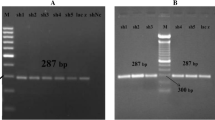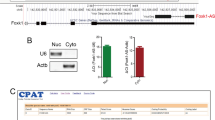Abstract
Activin receptor type IIB (ACVR2B) has been known to negatively regulate the muscle growth through mediating the action of transforming growth factor beta superfamily ligands. Recently, the artificial microRNAs (amiRNAs) which are processed by endogenous miRNA processing machinery have been proposed as promising approach for efficient gene knockdown. We evaluated amiRNAs targeting goat ACVR2B in HEK293T and goat myoblasts cells. The amiRNAs were designed based on the miR-155 backbone and cloned in 5′- and 3′-UTR of GFP reporter gene under the CMV promoter. Although both 5′- and 3′-UTR-amiRNAs vectors showed efficient synthesis of GFP transcripts, amiRNAs in 5′-UTR drastically affected GFP protein synthesis in transfected goat myoblast cells. Among the four amiRNAs targeting ACVR2B derived from either 5′- or 3′-UTR, ami318 showed highest silencing efficiency against exogenously co-expressed ACVR2B in both 293T and goat myoblast cells whereas ami204 showed highest silencing efficiency against endogenous ACVR2B in goat myoblasts cells. The 3′-UTR-derived amiRNA exerted higher knockdown efficiency against endogenous ACVR2B at transcript level whereas 5′-UTR-derived amiRNAs exerted higher knockdown efficiency at protein level. The expression of ACVR2B showed positive correlation with the expression of MYOD (r = 0.744; p = 0.009) and MYOG (r = 0.959; p = 0.000) in the amiRNA-transfected myoblasts. Although both 5′- and 3′-UTR–amiRNA vectors led to substantial induction of interferon response, the magnitude of the response was found to be higher with the 3′-UTR–amiRNA vectors.






Similar content being viewed by others
References
Amthor, H., Nicholas, G., McKinnell, I., Kemp, C. F., Sharma, M., Kambadur, R., & Patel, K. (2004). Follistatin complexes myostatin and antagonises myostatin-mediated inhibition of myogenesis. Developmental Biology, 270, 19–30.
Baek, M. N., Jung, K. H., Halder, D., Choi, M. R., Lee, B. H., Lee, B. C., Jung, M. H., Choi, I. G., Chung, M. K., Oh, D. Y., & Chai, Y. G. (2010). Artificial microRNA-based neurokinin-1 receptor gene silencing reduces alcohol consumption in mice. Neuroscience Letters, 475, 124–128.
Baquero-Perez, B., Kuchipudi, S. V., Nelli, R. K., & Chang, K. C. (2012). A simplified but robust method for the isolation of avian and mammalian muscle satellite cells. BMC Cell Biology, 13, 16.
Bentzinger, C. F., Wang, Y. X., & Rudnicki, M. A. (2012). Building muscle: Molecular regulation of myogenesis. Cold Spring Harbor Perspectives in Biology, 4, 1–16.
Bhomia, M., Sharma, A., Gayen, M., Gupta, P., & Maheshwari, R. K. (2013). Artificial microRNAs can effectively inhibit replication of Venezuelan equine encephalitis virus. Antiviral Research, 100, 429–434.
Boudreau, R. L., Martins, I., & Davidson, B. L. (2009). Artificial microRNAs as siRNA shuttles: Improved safety as compared to shRNAs in vitro and in vivo. Molecular therapy : The Journal of the American Society of Gene Therapy, 17, 169–175.
Cadena, S. M., Tomkinson, K. N., Monnell, T. E., Spaits, M. S., Kumar, R., Underwood, K. W., Pearsall, R. S., & Lachey, J. L. (2010). Administration of a soluble activin type IIB receptor promotes skeletal muscle growth independent of fiber type. Journal of Applied Physiology, 109, 635–642.
Du, G., Yonekubo, J., Zeng, Y., Osisami, M., & Frohman, M. A. (2006). Design of expression vectors for RNA interference based on miRNAs and RNA splicing. The FEBS Journal, 273, 5421–5427.
Eamens, A. L., Agius, C., Smith, N. A., Waterhouse, P. M., & Wang, M. B. (2011). Efficient silencing of endogenous microRNAs using artificial microRNAs in Arabidopsis thaliana. Molecular Plant, 4, 157–170.
Gantier, M. P., & Williams, B. R. (2007). The response of mammalian cells to double-stranded RNA. Cytokine & Growth Factor Reviews, 18, 363–371.
Giering, J. C., Grimm, D., Storm, T. A., & Kay, M. A. (2008). Expression of shRNA from a tissue-specific pol II promoter is an effective and safe RNAi therapeutic. Molecular Therapy : The Journal of the American Society of Gene Therapy, 16, 1630–1636.
Haidet, A. M., Rizo, L., Handy, C., Umapathi, P., Eagle, A., Shilling, C., Boue, D., Martin, P. T., Sahenk, Z., Mendell, J. R., & Kaspar, B. K. (2008). Long-term enhancement of skeletal muscle mass and strength by single gene administration of myostatin inhibitors. Proceedings of the National Academy of Sciences of the United States of America, 105, 4318–4322.
Hamrick, M. W., Arounleut, P., Kellum, E., Cain, M., Immel, D., & Liang, L. F. (2010). Recombinant myostatin (GDF-8) propeptide enhances the repair and regeneration of both muscle and bone in a model of deep penetrant musculoskeletal injury. Journal of Trauma, 69, 579–583.
Han, J., Lee, Y., Yeom, K. H., Kim, Y. K., Jin, H., & Kim, V. N. (2004). The Drosha-DGCR8 complex in primary microRNA processing. Genes & Development, 18, 3016–3027.
Hill, J. J., Davies, M. V., Pearson, A. A., Wang, J. H., Hewick, R. M., Wolfman, N. M., & Qiu, Y. (2002). The myostatin propeptide and the follistatin-related gene are inhibitory binding proteins of myostatin in normal serum. The Journal of Biological Chemistry, 277, 40735–40741.
Hirayama, E., Isobe, A., Okamoto, H., Nishioka, M., & Kim, J. (1997). Myogenin expression is necessary for commitment to differentiation and is closely related to src tyrosine kinase activity in quail myoblasts transformed with Rous sarcoma virus. European Journal of Cell Biology, 72, 133–141.
Hu, S., Ni, W., Sai, W., Zi, H., Qiao, J., Wang, P., Sheng, J., & Chen, C. (2013). Knockdown of myostatin expression by RNAi enhances muscle growth in transgenic sheep. PloS One, 8, e58521.
Hu, T., Fu, Q., Chen, P., Ma, L., Sin, O., & Guo, D. (2009). Construction of an artificial MicroRNA expression vector for simultaneous inhibition of multiple genes in mammalian cells. International Journal of Molecular Sciences, 10, 2158–2168.
Kozak, M. (2005). Regulation of translation via mRNA structure in prokaryotes and eukaryotes. Gene, 361, 13–37.
Lawlor, M. W., Read, B. P., Edelstein, R., Yang, N., Pierson, C. R., Stein, M. J., Wermer-Colan, A., Buj-Bello, A., Lachey, J. L., Seehra, J. S., & Beggs, A. H. (2011). Inhibition of activin receptor type IIB increases strength and lifespan in myotubularin-deficient mice. The American Journal of Pathology, 178, 784–793.
Lee, S. J., Reed, L. A., Davies, M. V., Girgenrath, S., Goad, M. E., Tomkinson, K. N., Wright, J. F., Barker, C., Ehrmantraut, G., Holmstrom, J., Trowell, B., Gertz, B., Jiang, M. S., Sebald, S. M., Matzuk, M., Li, E., Liang, L. F., Quattlebaum, E., Stotish, R. L., & Wolfman, N. M. (2005). Regulation of muscle growth by multiple ligands signaling through activin type II receptors. Proceedings of the National Academy of Sciences of the United States of America, 102, 18117–18122.
Lee, Y., Kim, M., Han, J., Yeom, K. H., Lee, S., Baek, S. H., & Kim, V. N. (2004). MicroRNA genes are transcribed by RNA polymerase II. The EMBO Journal, 23, 4051–4060.
Mastroyiannopoulos, N. P., Nicolaou, P., Anayasa, M., Uney, J. B., & Phylactou, L. A. (2012). Down-regulation of myogenin can reverse terminal muscle cell differentiation. PloS One, 7, e29896.
Milazzotto, M. P., Goissis, M. D., Feitosa, W. B., Martins, L. F., Strauss, B. E., Bajgelman, M. C., Assumpcao, M. E., & Visintin, J. A. (2010). Myostatin gene knockdown through lentiviral-mediated delivery of shRNA for in vitro production of transgenic bovine embryos. Zygote, 18, 339–344.
Miner, J. H., & Wold, B. J. (1991). c-myc inhibition of MyoD and myogenin-initiated myogenic differentiation. Molecular and Cellular Biology, 11, 2842–2851.
Oh, S. P., & Li, E. (1997). The signaling pathway mediated by the type IIB activin receptor controls axial patterning and lateral asymmetry in the mouse. Genes & Development, 11, 1812–1826.
Patel, A. K., Tripathi, A. K., Patel, U. A., Shah, R. K. and Joshi, C. G. (2014) Myostatin knockdown and its effect on myogenic gene expression program in stably transfected goat myoblasts. In vitro cellular & developmental biology. Animal.
Patel, A. K., Tripathi, A. K., Shah, R. K., Patel, U. A., & Joshi, C. G. (2014). Assessment of goat activin receptor type IIB knockdown by short hairpin RNAs in vitro. Journal of Receptor and Signal Transduction Research, 28, 1–7.
Rose, F. F., Jr., Mattis, V. B., Rindt, H., & Lorson, C. L. (2009). Delivery of recombinant follistatin lessens disease severity in a mouse model of spinal muscular atrophy. Human Molecular Genetics, 18, 997–1005.
Sablok, G., Perez-Quintero, A. L., Hassan, M., Tatarinova, T. V., & Lopez, C. (2011). Artificial microRNAs (amiRNAs) engineering—On how microRNA-based silencing methods have affected current plant silencing research. Biochemical and Biophysical Research Communications, 406, 315–319.
Shin, K. J., Wall, E. A., Zavzavadjian, J. R., Santat, L. A., Liu, J., Hwang, J. I., Rebres, R., Roach, T., Seaman, W., Simon, M. I., & Fraser, I. D. (2006). A single lentiviral vector platform for microRNA-based conditional RNA interference and coordinated transgene expression. Proceedings of the National Academy of Sciences of the United States of America, 103, 13759–13764.
Stewart, C. K., Li, J., & Golovan, S. P. (2008). Adverse effects induced by short hairpin RNA expression in porcine fetal fibroblasts. Biochemical and Biophysical Research Communications, 370, 113–117.
Sun, D., Melegari, M., Sridhar, S., Rogler, C. E., & Zhu, L. (2006). Multi-miRNA hairpin method that improves gene knockdown efficiency and provides linked multi-gene knockdown. BioTechniques, 41, 59–63.
Tripathi, A. K., Aparnathi, M. K., Patel, A. K., & Joshi, C. G. (2013). In vitro silencing of myostatiin gene by shRNAs in chicken embryonic myoblast cells. Biotechnology Progress, 29, 425–431.
Tripathi, A. K., Ramani, U. V., Ahir, V. B., Rank, D. N., & Joshi, C. G. (2010). A modified enrichment protocol for adult caprine skeletal muscle stem cell. Cytotechnology, 62, 483–488.
Tripathi, A. K., Ramani, U. V., Patel, A. K., Rank, D. N., & Joshi, C. G. (2013). Short hairpin RNA-induced myostatin gene silencing in caprine myoblast cells in vitro. Applied Biochemistry and Biotechnology, 169, 688–694.
Xiao, S., Wang, Q., Gao, J., Wang, L., He, Z., Mo, D., Liu, X., & Chen, Y. (2011). Inhibition of highly pathogenic PRRSV replication in MARC-145 cells by artificial microRNAs. Virology Journal, 8, 491.
Acknowledgments
Authors wish to thank National Agriculture Innovation Project (NAIP), New Delhi, India, and Anand Agricultural University, Gujarat, India, for providing necessary funding to carry out the research work.
Author information
Authors and Affiliations
Corresponding author
Rights and permissions
About this article
Cite this article
Patel, A.K., Shah, R.K., Parikh, I.K. et al. Goat Activin Receptor Type IIB Knockdown by Artificial MicroRNAs In Vitro. Appl Biochem Biotechnol 174, 424–436 (2014). https://doi.org/10.1007/s12010-014-1071-3
Received:
Accepted:
Published:
Issue Date:
DOI: https://doi.org/10.1007/s12010-014-1071-3




